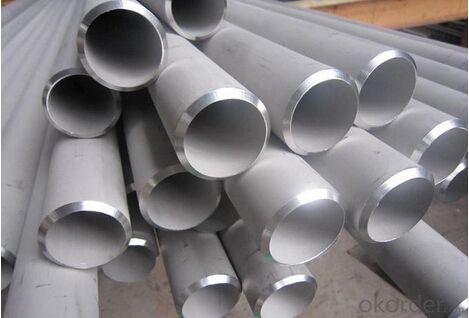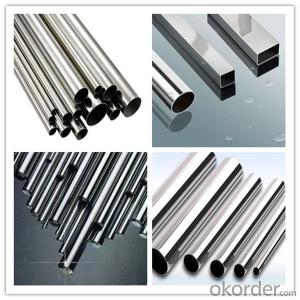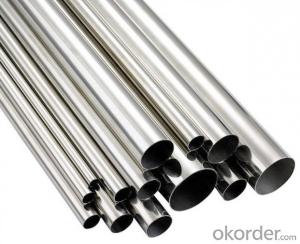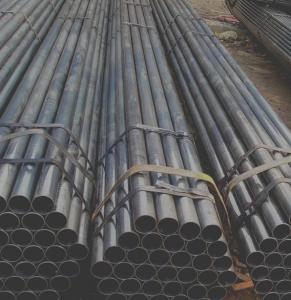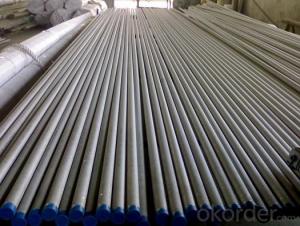Heat Exchanger Stainless Steel Pipe TP304 ASTM A213
- Loading Port:
- Ningbo
- Payment Terms:
- TT or LC
- Min Order Qty:
- 25 m.t.
- Supply Capability:
- 6000 m.t./month
OKorder Service Pledge
OKorder Financial Service
You Might Also Like
1、Structure of Heat Exchanger Stainless Steel Pipe TP304 ASTM A213
Heat Exchanger Stainless Steel Pipe TP304 ASTM A213 is formed by drawing a solid billet over a piercing rod to create the hollow shell. As the manufacturing process does not include any welding, Heat Exchanger Stainless Steel Pipe TP304 ASTM A213 are perceived to be stronger and more reliable. Historically Heat Exchanger Stainless Steel Pipe TP304 ASTM A213 was regarded as withstanding pressure better than other types, and was often more easily available than welded pipe.
2、Main Features of Heat Exchanger Stainless Steel Pipe TP304 ASTM A213
• High manufacturing accuracy
• High strength
• Small inertia resistance
• Strong heat dissipation ability
• Good visual effect
• Reasonable price
3、Heat Exchanger Stainless Steel Pipe TP304 ASTM A213 Specification:
Standard | GB, DIN, ASTM ASTM A106-2006, ASTM A53-2007 |
Grade | 10#-45#, 16Mn 10#, 20#, 45#, 16Mn |
Thickness | 8 - 33 mm |
Section Shape | Round |
Outer Diameter | 133 - 219 mm |
Place of Origin | Shandong, China (Mainland) |
Secondary Or Not | Non-secondary |
Application | Hydraulic Pipe |
Technique | Cold Drawn |
Certification | API |
Surface Treatment | factory state or painted black |
Special Pipe | API Pipe |
Alloy Or Not | Non-alloy |
Length | 5-12M |
Outer Diameter | 21.3-610mm |
Grade | 20#, 45#, Q345, API J55, API K55, API L80, API N80, API P110, A53B |
Standard | ASME, ASTM |
1) Material:20#(ASTM A 106/A53 GRB.API5LGRB,GB),45#,16Mn,10#.
2) Specification range:OD:21.3-610mm,WT:6-70mm,length:6-12m or according to the requirement of clients.
3) Excutive standards:GB,ASME API5L.ASTM A 106/A53,Despite of the above standards,we can also supply seamless steel pipe with standard of DIN,JIS,and so on,and also develop new products according to the requirements of our clients!
4) Surface:black lacquered,varnish coating or galvanized.
5) Ends:Beveled or square cut,plastic capped,painted.
6) Packing:bundles wrapped with strong steel strip,seaworthy packing.
4、Packaging & Delivery
Packaging Details: | seaworthy package,bundles wrapped with strong steel strip |
Delivery Detail: | 15-30days after received 30%TT |
5、FAQ of Heat Exchanger Stainless Steel Pipe TP304 ASTM A213
①How is the quality of your products?
Our products are manufactured strictly according to national and internaional standard, and we take a test
on every pipe before delivered out. If you want see our quality certifications and all kinds of testing report, please just ask us for it.
Guaranteed: If products’ quality don’t accord to discription as we give or the promise before you place order, we promise 100% refund.
②How about price?
Yes, we are factory and be able to give you lowest price below market one, and we have a policy that “ for saving time and absolutely honest business attitude, we quote as lowest as possible for any customer, and discount can be given according to quantity”,if you like bargain and factory price is not low enough as you think, just don’t waste your time.Please trust the quotation we would give you, it is professional one.
③Why should you chose us?
Chose happens because of quality, then price, We can give you both.Additionally, we can also offer professional products inquiry, products knowledge train(for agents), smooth goods delivery, exellent customer solution proposals.Our service formula: good quality+good price+good service=customer’s trust
SGS test is available, customer inspection before shipping is welcome, third party inspection is no problem.
6、Seamless Pipe ASTM A106/53 Images:
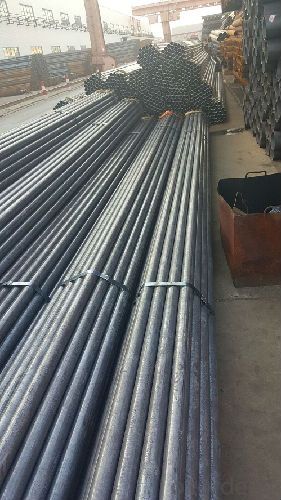
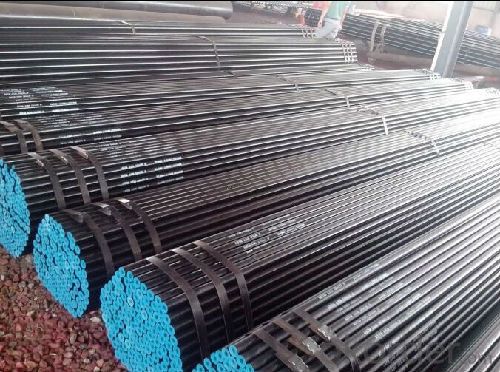
- Q: How do you prevent leakage in stainless steel pipes?
- One way to prevent leakage in stainless steel pipes is to ensure proper installation and fitting of the pipes. This includes using high-quality gaskets, seals, and compression fittings that are compatible with stainless steel. Additionally, regular inspection and maintenance of the pipes, including checking for any signs of corrosion or damage, can help identify and address potential leak points before they become problematic.
- Q: Can stainless steel pipes be used for pulp and paper industries?
- Yes, stainless steel pipes can be used for pulp and paper industries. Stainless steel pipes are highly resistant to corrosion and abrasion, making them suitable for the harsh and corrosive environments typically found in pulp and paper mills. They can withstand the corrosive chemicals and high temperatures associated with the production process, ensuring the longevity and reliability of the piping system. Additionally, stainless steel pipes have excellent mechanical properties, including high tensile strength and resistance to stress corrosion cracking, which are important for the efficient transportation of fluids and gases within the pulp and paper industry. Overall, stainless steel pipes offer a durable, hygienic, and cost-effective solution for piping requirements in the pulp and paper industries.
- Q: What is the average lead time for manufacturing stainless steel pipes?
- The average lead time for manufacturing stainless steel pipes can vary depending on several factors such as the complexity of the design, quantity required, and the manufacturer's production capacity. However, on average, it can range from a few weeks to a couple of months.
- Q: What are the different types of stainless steel pipe hangers?
- There are several different types of stainless steel pipe hangers available, each designed to suit specific applications and requirements. Some of the common types include: 1. Split ring hangers: These hangers consist of a split ring that wraps around the pipe, providing support and stability. They are easy to install and adjust, making them suitable for a wide range of pipe sizes. 2. Clevis hangers: Clevis hangers feature a U-shaped bracket that attaches to the pipe and is secured with a clevis pin. They offer excellent load-bearing capacity and are often used in vertical pipe installations. 3. Swivel ring hangers: Swivel ring hangers are designed to allow the pipe to move freely, accommodating thermal expansion and contraction. They consist of a circular ring that can rotate, reducing stress on the pipe. 4. Riser clamps: Riser clamps are used to support vertical pipes that run along walls or beams. They are available in various designs and can be adjustable to accommodate different pipe sizes and configurations. 5. Beam clamps: Beam clamps are used to secure pipes to overhead beams or structures. They typically have a bolt or threaded rod that attaches the clamp to the beam, providing a secure mounting point. 6. Pipe rollers: Pipe rollers are used to support pipes that need to move horizontally, such as in a sliding or rolling application. They consist of a set of rollers or wheels that allow the pipe to move smoothly. 7. Pipe straps: Pipe straps are simple, cost-effective hangers that wrap around the pipe and attach to a surface using screws or bolts. They are commonly used for light-duty applications or where space is limited. 8. Pipe saddles: Pipe saddles are used to support pipes that need to be raised or protected from direct contact with a surface. They typically have a curved or U-shaped design that cradles the pipe. It is important to select the appropriate type of stainless steel pipe hanger based on the specific requirements of the installation, including pipe size, load capacity, movement, and environmental factors. Consulting with a knowledgeable supplier or engineer can help in choosing the right hanger for the job.
- Q: Are stainless steel pipes resistant to stress corrosion cracking?
- In general, stainless steel pipes exhibit resistance to stress corrosion cracking. Stainless steel is a material known for its ability to resist corrosion and degradation, thanks to its high levels of chromium and nickel. The occurrence of stress corrosion cracking is typically triggered by a combination of tensile stress, a corrosive environment, and a susceptible material. Nevertheless, stainless steel demonstrates excellent resistance against stress corrosion cracking due to its composition and inherent properties. It can endure high levels of stress without experiencing significant degradation or cracking, making it a suitable choice for applications that necessitate durability and corrosion resistance.
- Q: Can stainless steel pipes be used for steam systems?
- Yes, stainless steel pipes can be used for steam systems. Stainless steel has excellent resistance to high temperatures and corrosion, making it a suitable material for steam applications. It ensures reliable and long-lasting performance in steam systems, providing a safe and efficient transportation of steam.
- Q: How do you prevent noise transmission in stainless steel pipes?
- To prevent noise transmission in stainless steel pipes, various measures can be taken. One effective method is to use acoustic insulation materials, such as foam or rubber, to wrap around the pipes. This helps absorb and dampen the sound waves, reducing noise transmission. Additionally, installing vibration isolators or flexible pipe connectors at connecting points can minimize the transfer of vibrations and noise. Properly securing the pipes and ensuring they are properly supported can also help prevent noise transmission by reducing any rattling or vibrations.
- Q: What is the difference between 347 and 316 stainless steel pipes?
- The composition and intended use are what sets 347 and 316 stainless steel pipes apart. 347 stainless steel pipes have a higher percentage of niobium, which enhances their stability at high temperatures and resistance to sensitization. This makes them ideal for applications where the pipes will be exposed to elevated temperatures, such as in heat exchangers, furnace parts, and chemical processing equipment. The addition of niobium also improves their resistance to intergranular corrosion. On the other hand, 316 stainless steel pipes consist of molybdenum, which provides increased resistance to corrosion and pitting. This makes them suitable for applications involving exposure to harsh chemicals, saltwater, and other corrosive environments. They are commonly used in industries such as marine, pharmaceutical, and food processing. Both grades have excellent strength and corrosion resistance in terms of mechanical properties. However, 347 stainless steel is generally more expensive than 316 stainless steel due to its higher nickel content. Ultimately, the choice between 347 and 316 stainless steel pipes depends on the specific requirements of the application. If high-temperature stability and resistance to sensitization are crucial, 347 stainless steel pipes would be the preferred option. If the primary concern is corrosion resistance, particularly in harsh environments, 316 stainless steel pipes would be more suitable.
- Q: Can stainless steel pipes be used for chemical storage tanks?
- Indeed, stainless steel pipes have the capability to serve as chemical storage tanks. Renowned for its exceptional resistance to corrosion, stainless steel proves to be an optimal substance for the containment of chemicals. An extensive array of chemicals, such as acids, alkalis, solvents, and gases, face no challenge in penetrating its defenses. Furthermore, stainless steel boasts durability and strength, guaranteeing the structural integrity of the storage tanks. Moreover, its effortless cleaning and maintenance render it suitable for housing various types of chemicals. Nevertheless, one must exercise caution and thoroughly consider the specific properties and demands of the chemicals before opting for stainless steel pipes as chemical storage tanks.
- Q: Can stainless steel pipes be used in the mining industry?
- Indeed, the mining industry can make use of stainless steel pipes. Stainless steel, as a material, is highly durable and resistant to corrosion, which makes it perfect for the harsh and demanding conditions often encountered in mining operations. The mining industry involves the extraction and processing of various minerals and ores, which frequently necessitate the use of corrosive chemicals and high-pressure fluids. Stainless steel pipes possess the ability to withstand these challenging conditions and provide reliable and long-lasting performance. One of the primary advantages of stainless steel pipes in the mining industry lies in their corrosion resistance. The mining environment typically contains corrosive substances like saltwater, acids, and various chemicals employed in mineral extraction and processing. Stainless steel pipes can resist these corrosive elements, ensuring that they do not deteriorate or weaken over time. Consequently, they are ideal for transporting fluids and gases in mining operations. Aside from their resistance to corrosion, stainless steel pipes also exhibit exceptional strength and durability. They can endure high pressures and temperatures, making them suitable for handling the demanding conditions of the mining industry. Additionally, stainless steel pipes are known for their low maintenance requirements, which is particularly crucial in remote mining areas where accessibility and maintenance can be challenging. Moreover, stainless steel pipes are versatile and can be utilized in various applications within the mining industry. They can be employed for transporting water, slurry, and other fluids, as well as for ventilation systems, structural components, and even lining mine shafts. Their versatility and durability make them a cost-effective choice for mining companies, as they can be used in a wide range of applications and have a long service life. In summary, stainless steel pipes are a dependable and long-lasting option for the mining industry. Their resistance to corrosion, high strength, and versatility make them well-suited for the demanding conditions encountered in mining operations. By utilizing stainless steel pipes, mining companies can ensure the efficient and safe transportation of fluids and gases, thus contributing to the success and productivity of their operations.
Send your message to us
Heat Exchanger Stainless Steel Pipe TP304 ASTM A213
- Loading Port:
- Ningbo
- Payment Terms:
- TT or LC
- Min Order Qty:
- 25 m.t.
- Supply Capability:
- 6000 m.t./month
OKorder Service Pledge
OKorder Financial Service
Similar products
Hot products
Hot Searches
Related keywords




